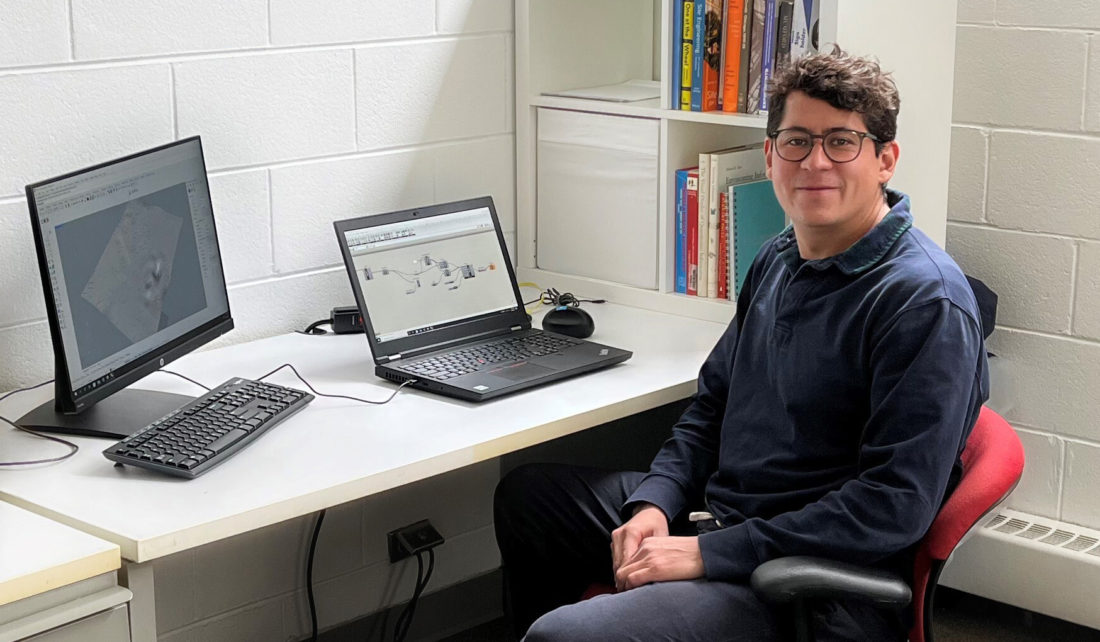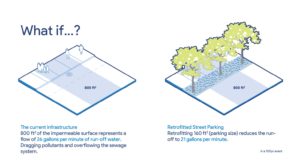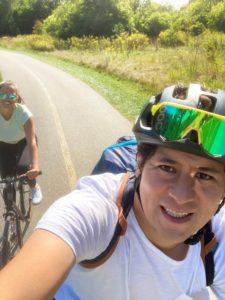
“Meet Our Grad Student Scholars” is an article series from Illinois-Indiana Sea Grant (IISG) celebrating the graduate students doing research funded by the IISG scholars program. To learn more about our faculty and graduate student funding opportunities, visit our Fellowships & Scholarships page. Alexis Arias is a doctoral student in the College of Architecture at the Illinois Institute of Technology, and part of inaugural Illinois-Indiana Sea Grant Graduate Student Scholars cohort. He is studying the urban design implications of driverless vehicles. In his current work—which is also supported by the National Science Foundation—he interviews transportation, water management and policy experts to help him design models for better urban water treatment. He is broadly interested in how upcoming technologies can help maintain or create positive social and environmental benefits for cities and the many stakeholders in and around them.
For many, the idea of driverless cities may belong in a futuristic world or on a different planet, but this is not the case for Illinois-Indiana Sea Grant Graduate Student Scholar Alexis Arias. A PhD student at the Illinois Institute for Technology, Alexis is part of the Driverless City Project team. Collectively, the team is exploring how planning decisions would change for cities that use self-driven transportation services. For his Illinois-Indiana Sea Grant-supported piece of the work, Alexis is specifically interested in how driverless cars will affect urban water quality in and around Chicago. While car developers are understandably focused on the safety and technology of driverless cars, no one knows much about their environmental impact. Alexis believes driverless cars are “a sort of environmental Trojan Horse” and hopes his research can ultimately be useful to developers, industry leaders and others who design infrastructure. Alexis shared, “I would like for them to be able to employ new technologies to achieve desirable social and environmental benefits.”
In his first stage of research, Alexis is interviewing experts in urban water, and transportation infrastructure, and policy. This includes planners, landscape architects, academic researchers, and representatives from the Chicago City Council, Metropolitan Planning Council of Chicago, and the Metropolitan Water Reclamation District. Alexis is aware that his interviewees are very busy, so once someone has agreed to an interview, he and his collaborators carefully craft questions for that particular chat.
Overall, the main objective of all Alexis’ interviews is to answer two questions: Firstly, how does current transportation infrastructure affect urban waters? And secondly, how can we employ new mobility technologies to improve the health of urban waters?

Alexis Arias holds a virtual interview with Mary Pat McGuire of the University of Illinois at Urbana-Champaign.
Experts agree that two major sources of pollution in cities are stormwater runoff and point-source pollution from impervious surfaces including gas stations, garages and parking lots. Some of Alexis’ interviewees have suggested that driverless cars may need far fewer parking spaces, street lanes and gas stations as they become increasingly efficient and electrified. Reduced infrastructure could lead to less pollution, which could be a great benefit to waterways in and around Chicago. In addition to predicting changes in the amount of pollution, Alexis is exploring what can be done to remediate contaminated land and water. Possibilities include repurposing old infrastructure, changing the way that roads are paved and exploring land use ordinances changes. Any and all of these changes could lead to positive outcomes for humans and other lifeforms that rely on clean water sources.
After the expert interviews, it is time to quantify gathered information. Alexis’ favorite research activity comes after the interviews are transcribed. “We are getting the big ideas from experts and trying to create models. We have to figure out ways to put this into GIS mapping and 3D models to generate predictions,” he said. “The fun part is when we start developing scenarios and use a lot of computational assisted drawing systems.” For this, Alexis uses around eight types of software: AutoCAD, Rhino, GIS, Adobe Illustrator, Photoshop, Ladybug, Honeybee and Grasshopper. Each program serves a specific purpose that can help predict pollution as accurately as possible. For example, Grasshopper software allows Alexis to develop parametrical models, which are based on pre-programmed plugins that help with environmental analysis. According to Alexis, “The cool part is when we see how all of these programs work together.”

The research team that Alexis Arias is part of asks “What If?” questions. What if Driverless Cars don’t need parking or service? Can we retrofit those spaces for social and environmental purposes? If we retrofit street parking into water management systems, we can reduce the runoff water in a 100-year event by 20% from about 26 gallons per minute to 21 gallons per minute.
While the main goal is to produce data-driven predictions about urban water quality, Alexis has been pleasantly surprised by social ideas for driverless cars that have come up during the interviews. Experts have exciting ideas for how to write public policy, use public funds for infrastructure, and use urban planning code for education. Alexis says each interview has been a fruitful learning process and he always leaves excited about new ways to use urban planning to improve quality of life and water quality simultaneously.

 This doctoral project is massive and requires a lot of time management. Alexis spends his mornings researching driverless cars and collaborating with other people in his lab. In the afternoons, he works on modeling, which is mostly self-taught. Some days can be frustrating, and others are very satisfying. To anyone considering pursuing graduate school, Alexis recommended, “Be very open-minded about where grad school will take you.” His time in the Illinois Institute of Technology’s architectural school began with a life-changing layover, and he has ended up working with people in many other departments by asking big questions and making an effort to connect with his mentors. In his free time, Alexis enjoys biking along the Chicago Lakefront Trail with his girlfriend, Jacqueline, and enjoying Lake Michigan with his puppy Pacha (Pachamama).
This doctoral project is massive and requires a lot of time management. Alexis spends his mornings researching driverless cars and collaborating with other people in his lab. In the afternoons, he works on modeling, which is mostly self-taught. Some days can be frustrating, and others are very satisfying. To anyone considering pursuing graduate school, Alexis recommended, “Be very open-minded about where grad school will take you.” His time in the Illinois Institute of Technology’s architectural school began with a life-changing layover, and he has ended up working with people in many other departments by asking big questions and making an effort to connect with his mentors. In his free time, Alexis enjoys biking along the Chicago Lakefront Trail with his girlfriend, Jacqueline, and enjoying Lake Michigan with his puppy Pacha (Pachamama).
You can learn more about Alexis’s research and the Driverless City Project by following the social media accounts listed here: https://www.thedriverlesscityproject.org/contact.
Illinois-Indiana Sea Grant is a part of University of Illinois Extension and Purdue Extension.
Writer: Sarah Gediman
Contact: Carolyn Foley

